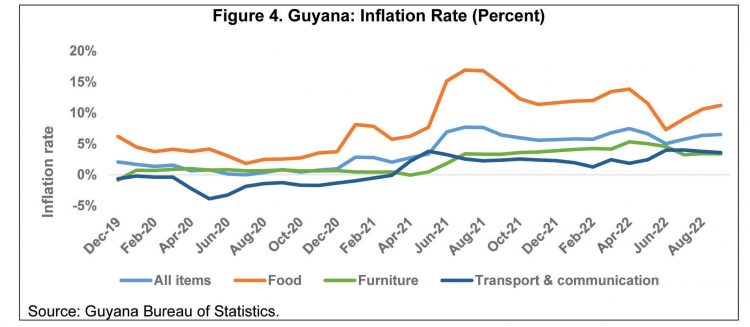While noting that the Guyana Government has implemented a series of measures to ease the cost of living burden, a recent Inter-American Development Bank (IDB) report has raised concerns over the inflation level here and its impact on purchasing power.
According to the report `Headwinds facing the post-pandemic recovery’, the annual inflation rate was 2.1 percent in December 2019, remained subdued through 2020 and early 2021, and then reached 6.9 percent in June 2021.
“The inflation rate averaged 6.6 percent in the second half of 2021 and 6.2 percent through September 2022. More notably, food prices have seen even higher rates of inflation, averaging 11.2 percent this year through September,” said the report.

It was further noted that a recent IDB study, Arias et al. (2022), estimates that a 20 percent increase in food prices in 23 countries in Latin America and the Caribbean would lead to an increase of 1.6 percent in moderate poverty and 1.8 percent in extreme poverty, increasing the total number of people living in moderate and extreme poverty by 9.8 million and 10.8 million, respectively.
For Guyana this is even though the annual average GDP growth estimates has increased from 22.5 percent to 31.6 percent over 2022 to 2026.
“Guyana’s macroeconomic context continues to be one of a booming economy, with oil production driving growth in exports, GDP growth, and government revenues and expenditures in the medium term. In its October 2022 World Economic Outlook (WEO), the International Monetary Fund (IMF) increased its estimates for oil production and GDP growth as a result of incorporating oil production from two additional floating, production, storage, and offloading (FPSO) vessels. In addition to considering higher levels of oil production, the new estimates account for higher energy prices, significantly supporting Guyana’s main export flows,” the IDB report said.
Guyana’s volume of exported goods is projected to increase by an annual average of 50 percent over 2022–2026, as opposed to the IMF’s earlier estimate of 22.5 percent in its April 2022 WEO, according to the report.
However, this is mainly due to the inclusion of additional FPSOs which the IMF estimates also almost doubled annual average GDP growth estimates.
The IDB report predicts that the Government revenues and expenditures are expected to follow a similar trend, averaging annual growth rates of 20 percent and 11 percent, respectively, over 2022–2026, leading to fiscal primary surpluses and near balanced budgets in the medium term.
“GDP growth is expected to significantly expand in 2022 and includes stronger recoveries in some non-oil sectors. The GDP growth rate in 2021 was 20.1 percent. GDP is expected to expand by a further 56 percent in 2022 on the back of increased oil production, as the Liza 2 field came online in February,” stated the report.
The oil sector is expected to expand by 113 percent in 2022, accounting for approximately 90 percent of GDP growth this year.
As for the non-oil economy, it is projected to have a better-than-expected turnout of 9.6 percent for 2022 compared to 7.7 percent projected in the country’s 2022 budget.
It was stated that the main drivers of growth in the non-oil economy include agriculture, services, and construction, which are projected to grow by 11.9 percent, 6.3 percent, and 19 percent, respectively, all higher than originally estimated in the budget.
“All three sectors showed dynamic growth in their mid-year results. In contrast, gold production and the manufacturing sector contracted in the first semester of 2022, leading to a downward revision of growth estimates for the year for those sectors to 7.4 percent and 7.5 percent, respectively,” the report said.
As it is Guyana’s development is two-fold, considering that the country is not only benefitting from higher energy prices but also from higher levels of oil production.
Policy responses
The report pointed out that Guyana has initiated several policy responses to address some of the challenges it faces, even in light of its increased GDP growth. The fiscal sector has benefitted from higher payments to the Natural Resource Fund, which had received a total of US$1.45 billion through September 2022 since its inception in 2020, including almost US$840 million in 2022.
Second, to strengthen food security, the report noted that the government has promoted the Vision 2025 by 25 policy initiative, which seeks to reduce extra CARICOM food imports by 25 percent by 2025. Third, Guyana is among the governments in the region that have been holding investment fora to promote technological improvements in agriculture and foreign direct investment.
At the micro level, to support productive sectors and vulnerable populations, the report said that the excise tax on petroleum was reduced from 20 to 10 percent in
January, then lowered further to zero in March. Tariffs on public utility services such as water and electricity have remained fixed, with the government taking up higher operating costs. US$4.8 million was also allocated for the purchase and distribution of fertilizer for farmers to lower operating costs, and US$ 3.8 million was sharedin the form of one-time cash grants for households in the rural interior and riverain communities (US$120 per household). Further, the government’s public assistance payments for vulnerable populations were upped from US$57 to US$67 per person per month, benefitting approximately 18,000 people. The payments were
later expanded to provide lifelong support for people with permanent disabilities. The Old Age Pension, which benefits approximately 65,000 senior citizens, saw a series of increases that brought it from a monthly payment of US$98 in 2020 to US$134 in 2022, the report said.






